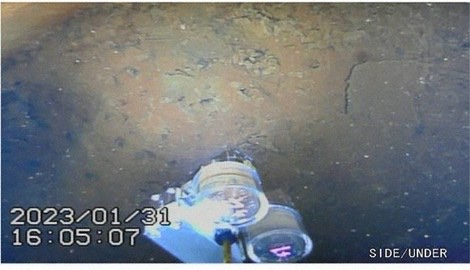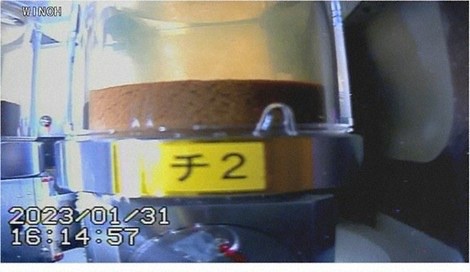

Fukushima Daiichi Nuclear Power Station Unit 1: Collecting debris with an underwater robot!
– To elucidate the composition of debris deposits –
Tokyo Electric Power Company: Fukushima Daiichi Nuclear Power Station Unit 1
On February 1st, TEPCO
“We collected sediment from the bottom of the containment vessel using an underwater robot,” the company announced.
It has a two-layer structure of “melted nuclear fuel debris and the sediments that have accumulated on it.”
In order to extract the debris, the challenge is to elucidate the composition of the debris deposits.
Robotic debris collection:
TEPCO collected samples at two locations this time.
In the future, we plan to introduce the robot again and collect at two other locations.
Debris container:
The container containing the sediment had a maximum of about 0.65mm sievert per hour.
It was below the prescribed radiation dose (2 mm sievert) and was removed from the reactor containment vessel.
From now on, it will be transferred to a radiation shielding container and transferred to an analysis facility.
(Mainichi Shimbun)-Yahoo! News
https://news.yahoo.co.jp/articles/cd37d5abfbdb35cb40f1eac852164060082f18c1
Unité 1 de la centrale nucléaire de Fukushima Daiichi : collecte de débris avec un robot sous-marin !
– Élucider la composition des dépôts de débris –
Tokyo Electric Power Company : Unité 1 de la centrale nucléaire de Fukushima Daiichi
Le 1er février, TEPCO
“Nous avons collecté des sédiments au fond de la cuve de confinement à l’aide d’un robot sous-marin”, a annoncé la société.
Il a une structure à deux couches de “débris de combustible nucléaire fondu et des sédiments qui s’y sont accumulés”.
Afin d’extraire les débris, le défi consiste à élucider la composition des dépôts de débris.
Collecte de débris robotisée :
TEPCO a collecté des échantillons à deux endroits cette fois.
À l’avenir, nous prévoyons de réintroduire le robot et de le récupérer à deux autres endroits.
Conteneur à débris :
Le récipient contenant le sédiment avait un maximum d’environ 0,65 mm de sievert par heure.
Il était inférieur à la dose de rayonnement prescrite (2 mm sievert) et a été retiré de l’enceinte de confinement du réacteur.
Désormais, il sera transféré dans un conteneur de radioprotection et transféré vers une installation d’analyse.
(Mainichi Shimbun) – Nouvelles de Yahoo!
Kernkraftwerk Fukushima Daiichi Block 1: Trümmer einsammeln mit einem Unterwasserroboter!
– Zur Aufklärung der Zusammensetzung von Schuttablagerungen –
Tokyo Electric Power Company: Kernkraftwerk Fukushima Daiichi Block 1
Am 1. Februar hat TEPCO
„Wir haben mit einem Unterwasserroboter Sedimente vom Boden des Sicherheitsbehälters gesammelt“, kündigte das Unternehmen an.
Es hat eine zweischichtige Struktur aus “geschmolzenem Kernbrennstoffschutt und den darauf angesammelten Sedimenten”.
Um den Schutt zu extrahieren, besteht die Herausforderung darin, die Zusammensetzung der Schuttablagerungen aufzuklären.
Robotische Müllabfuhr:
TEPCO sammelte diesmal Proben an zwei Orten.
In Zukunft planen wir, den Roboter wieder einzuführen und an zwei weiteren Standorten zu sammeln.
Abfallbehälter:
Der Behälter mit dem Sediment hatte maximal etwa 0,65 mm Sievert pro Stunde.
Sie lag unterhalb der vorgeschriebenen Strahlendosis (2 mm Sievert) und wurde aus dem Reaktorsicherheitsbehälter entfernt.
Von nun an wird es in einen Strahlenschutzbehälter umgefüllt und einer Analyseeinrichtung zugeführt.
(Mainichi Shimbun) – Yahoo!-Nachrichten
TEPCO: Fuel debris samples taken from damaged Fukushima Daiichi nuclear reactor
NHK WORLD-JAPAN News
The operator of the crippled Fukushima Daiichi nuclear power plant says
it has retrieved samples from inside the No. 1 reactor containment vessel.
It says the samples are likely to contain fuel debris.
The plant suffered
a triple meltdown in the March 2011 earthquake and tsunami.
Its operator,
Tokyo Electric Power Company, or TEPCO,
said on Wednesday that underwater robots successfully sucked water out from two locations inside the vessel.
The company has been examining the inside of the No.1 reactor containment vessel.
It says
the accumulated matter at the bottom is thought to contain fuel debris.
The project
to collect samples initially began early last month, but was suspended due to technical errors.
It was resumed on Tuesday.
Experts hope that
a close analysis of the samples will help lead to successful removal of fuel debris — one of the greatest challenges in the plant’s decommissioning process.
TEPCO said
it will try taking samples from two other locations inside the vessel.
It also said
it will spend about a year identifying the types and amounts of chemical elements contained in the samples.
The company also plans
to send robotic cameras inside the pedestal, a structure that props up the reactor.